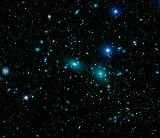
NGC 4889
Encyclopedia
NGC 4889, also known as Caldwell 35, is a supergiant class-4 elliptical galaxy
, the brightest within the Coma cluster and a Caldwell object
in the constellation Coma Berenices
. It shines at magnitude +11.4. Its celestial coordinates are RA 13h00.1m, DEC +27°59'. It is located near the G-class naked-eye star Beta Comae Berenices
, the galaxy NGC 4874
(also in the Coma Cluster), and the North Galactic Pole. It lies roughly 308 million light-year
s away. The main cluster is retreating at roughly 7000 km/s, while NGC 4889 itself is retreating at 6495 km/s.
Elliptical galaxy
An elliptical galaxy is a galaxy having an approximately ellipsoidal shape and a smooth, nearly featureless brightness profile. They range in shape from nearly spherical to highly flat and in size from hundreds of millions to over one trillion stars...
, the brightest within the Coma cluster and a Caldwell object
Caldwell catalogue
The Caldwell Catalogue is an astronomical catalog of 109 bright star clusters, nebulae, and galaxies for observation by amateur astronomers. The list was compiled by Sir Patrick Caldwell-Moore, better known as Patrick Moore, as a complement to the Messier Catalogue.The Messier Catalogue is used...
in the constellation Coma Berenices
Coma Berenices
Coma Berenices is a traditional asterism that has since been defined as one of the 88 modern constellations. It is located near Leo, to which it formerly belonged, and accommodates the North Galactic Pole...
. It shines at magnitude +11.4. Its celestial coordinates are RA 13h00.1m, DEC +27°59'. It is located near the G-class naked-eye star Beta Comae Berenices
Beta Comae Berenices
Beta Comae Berenices is a main sequence dwarf star in the constellation of Coma Berenices. It is located at a distance of about 30 light years. The Greek letter beta usually indicates that the star has the second highest visual magnitude in the constellation...
, the galaxy NGC 4874
NGC 4874
NGC 4874 is giant elliptical galaxy, about ten times larger than the Milky Way, at the centre of the Coma Galaxy Cluster. With its strong gravitational pull, it is able to hold onto more than 30.000 globular clusters of stars and even has a few dwarf galaxies in its grasp....
(also in the Coma Cluster), and the North Galactic Pole. It lies roughly 308 million light-year
Light-year
A light-year, also light year or lightyear is a unit of length, equal to just under 10 trillion kilometres...
s away. The main cluster is retreating at roughly 7000 km/s, while NGC 4889 itself is retreating at 6495 km/s.

